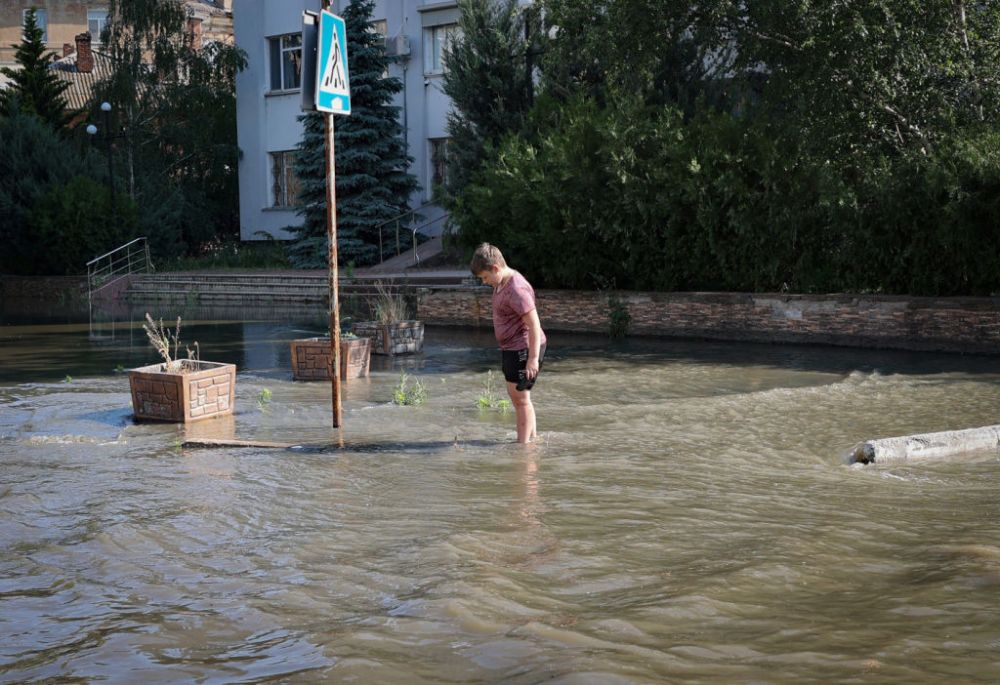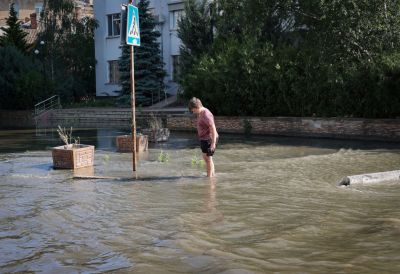Every sensational attack in the Ukraine war is a whodunnit.
Russians are capable of anything, of course. They’re always suspects.
But rarely can one firmly rule out Ukrainian responsibility. For them the stakes of the war are existential, so they’re necessarily ruthless in pursuing victory. And they’ve proved more capable of spectacular operations, including deep behind enemy lines, than anyone believed possible before February 2022.
That drone fly-by of the Kremlin last month? That was them, as your humble correspondent surmised. Assassinations of Russian propagandists? Them. Last year’s explosion on the Kerch Strait Bridge? Them. The sinking of the Moskva? Them.
Sabotage of the Nord Stream pipeline? Them too, probably.
The same goes for the recent mysterious armed incursion into the Russian province of Belgorod, although in that case a line has been carefully drawn between “Ukrainian forces” and “independent anti-Russian militias” to preserve a bit of plausible deniability. Which, ironically, is a tactic Vladimir Putin should appreciate.
But this morning’s breach of the Nova Kakhovka dam in southern Ukraine doesn’t smell like a Ukrainian operation, spectacular though it is. It has the hallmarks of the Russian way of war.
The Nova Kakhovka reservoir held nearly 5 billion gallons of water, on par with the Great Salt Lake. It’s now emptying out into terrain on both sides of the Dnipro River, triggering the immediate evacuation of 17,000 people and lesser disasters great and small. Tons of oil have spilled into the river; homes are being swept away; landmines unearthed by the water may be washed into populated areas; zoo animals have drowned by the hundreds.
The streets of downtown Nova Kakhovka now belong to the swans, although Russian apparatchiks remain as dogged as ever in insisting that all is welll—even with evidence to the contrary in plain view.
Some observers on social media are using the word “ecocide” to describe the aftermath, a clunky term that nonetheless efficiently captures the scale of the damage. Reconstructing Ukraine after the war was destined to be a mammoth project; as of this afternoon it’s even more costly and complex.
The only good news has to do with the Zaporizhzhia nuclear plant, Europe’s largest. The plant relies on the now-depleting reservoir for water to cool its fuel rods; a dam failure would have caused a major crisis if the reactors were still operating. They aren’t. Five of the six were placed in “cold shutdown” last September while the sixth is in “warm shutdown,” requiring little water to maintain the plant safely. In its zeal to starve the Ukrainians of energy earlier in the war, the Russians inadvertently disaster-proofed Zaporizhzhia.
So then: Whodunnit?
The mystery of the exploding dam seems easier to solve than the case of the Kremlin drone a few weeks ago.
We have here a display of flabbergasting indifference to human life; deliberate targeting of civilians; crude blunt force instead of precision strikes; and defiant contempt for the laws of war. That’s as close to a Russian signature in battle as one can get. The flooding unleashed by the dam’s demolition feels like a metaphor for the entire conflict, in fact, insofar as the destruction is indiscriminate and seems designed to punish the Ukrainians for not surrendering more so than to achieve any particular strategic end.
But let’s back up. It may surprise you to learn that there are other theories circulating today to explain the dam’s failure beside the obvious one.
Could it be that the dam burst not because the Russians demolished the structure deliberately but because they were too incompetent to maintain it properly after seizing it early in the war?
Remember, these are the same idiots who made camp in the Red Forest around Chernobyl after they took over the plant there. Russia isn’t sending its best.
There was evidence before today that maintenance trouble might be looming at the dam, in fact.
Three weeks ago the New York Times published a story tracking alarming and unexplained fluctuations in the water level of the Nova Kakhovka reservoir. Over the winter that level had fallen to an historic low, causing concern among Ukrainians locally. “Recent videos and satellite imagery from late last year show that at least three of the gates that control the flow of water through the dam were opened—apparently by Russian forces,” the Times reported. As water rushed through the gates for months, the reservoir slowly began to drain.
Complaints evidently led the Russians in charge of the dam to try to correct the problem—or overcorrect, it turns out. Last month the water level in the reservoir was higher than it’s been in decades, so much so that water began to flow over the top. One expert speculated that “Russian forces … kept too few gates open to control the flow of winter snowmelt and spring rains.”
How this sort of fluctuation in the water level might affect the structural integrity of a dam is above my pay grade, but the Associated Press reminded readers today that last fall Russian troops in charge of the dam “detonated explosives that damaged three sluice gates, which help regulate water levels when operated properly. Signs of damage to the gates were evident in late May.” What if a damaged and unrepaired (or ineptly repaired) dam under strain from an unprecedented volume of water failed catastrophically?
There’s a problem with that theory, though. Numerous reports suggest there was an explosion at the dam. A big one.
One observer who closely followed the early Russian media bulletins this morning speculated that this was less a case of incompetence than malice aggravated by incompetence. Maybe the Russians tried to blow up a “small part” of the dam, hoping that the water released would force Ukrainian troops stationed on islands in the Dnipro downstream to evacuate. But the explosion ended up damaging a large part, not a small part, causing a calamity and leaving the Kremlin scrambling for explanations about what had happened.
Could the Russians really have been so stupid as to attempt a sort of “controlled partial demolition” of a dam that was already under intense pressure? We might answer that question with a question: Could they really have been so stupid as to still be using cell phones on the front lines months after it became clear that the Ukrainians were using the signals to pinpoint their positions?
There’s another theory kicking around that doesn’t involve Russian incompetence. Namely, Ukrainian forces blew up the dam.
That would be shockingly callous given the consequences to Ukrainian citizens who live near the Dnipro. The war effort would need to benefit enormously in order to justify it. Will it?
There are some benefits, it turns out, although whether they qualify as “enormous” is for the reader to judge. The most obvious one is that the flooding won’t just displace local Ukrainians, it’ll displace Russian troops dug in on the left bank of the river and wash away fortifications and minefields. Russian military bloggers are already paranoid about the start of Ukraine’s summer counteroffensive and the dam’s destruction has done nothing to calm them.
Igor Girkin, who led Russia’s effort in the Donbas in 2014, noted that the falling water level north of the dam will make it easier for the Ukrainians to ford the Dnipro there, requiring Russia to hurriedly send reserves and possibly leave other parts of the front less well defended.
Ukraine benefits in another way from the dam’s collapse. Without the Nova Kakhovka reservoir feeding water to an important canal, Russian-controlled Crimea will soon be at risk of dying of thirst.
The Russians seized the [Nova Kakhovka] dam in February 2022, a strategic move aimed at disrupting hydroelectrical power in Ukraine and allowing water to flow to the Crimean Peninsula. After Russia occupied and illegally annexed Crimea in 2014, Ukraine cut off the water supply flowing from the dam’s reservoir.
Supplying fresh water to Crimea had become a huge burden on Russia’s budget. In 2020, the Kremlin had approved more than $650 million for it.
…
“Since the level of water in the reservoir dropped, this channel cannot function,” [Nova Kakhovka Mayor Volodymyr] Kovalenko said, referring to the canal that carries water from the dam to Crimea. He said the channel needed 10 feet of water to operate, and if it drops below that, no water could flow.
Capturing Crimea was the crowning glory of Putin’s attack on Ukraine nine years ago. Recapturing it has featured heavily in speculation about the strategic ambitions of Ukraine’s coming counteroffensive. Ousting Russia from the peninsula would cut the Kremlin off from its most important naval base and humiliate Putin like nothing else could, turning his imperial war into a net loser for Russia as measured by territory.
But for now, depriving Crimea of water would be an efficient way to show the Russian people that its government is no longer in control of events in territory which the Kremlin most eagerly wants to protect. How Russian forces can defend the peninsula effectively without supplies of fresh water from the canal is now an open question. In fact, when a Putin spokesman was asked this morning who destroyed the dam, he blamed Ukraine—and identified the water supply to Crimea as the specific reason.
It’s an interesting, if horrifying, possibility. As understandable as the Ukrainians’ desperation to gain ground against the Russians is, engineering a mass flood that’s destined to kill many innocents on their own side would be impossible to defend morally.
Fortunately, we don’t need to.
Russia is the aggressor in this conflict. As such, irrespective of who pushed the plunger on the dam, the fact remains that this flood wouldn’t be happening had Russia not invaded.
But it probably was a Russian who pushed that plunger. Russia, not Ukraine, likely destroyed the dam because this is the sort of thing Russia does.
And because the timing is a little too fortuitous to be coincidental.
It was just this morning, around the time the dam was giving way, that my colleagues at The Morning Dispatch reported that Ukraine’s counteroffensive seems at long last to be underway. Since Sunday there’s been an uptick in Ukrainian artillery fire and ground assaults in the East. Perhaps the Russians had intelligence about where Ukraine was planning to advance and feared they couldn’t hold them off with conventional means. Or perhaps they’ve grown so spooked by propaganda about the ferocity of the coming offensive that they felt obliged to do something drastic to upset Ukrainian planning as operations began.
Whatever the case, Russia had various incentives to flood the South. Some Ukrainian troops will now be diverted from their missions to conduct rescue operations; others hoping to advance in the South might now find the terrain impassable; Russian forces will have extra time to adjust and redeploy units strategically to counter whatever Ukraine seems to be planning; and millions might lose power, complicating military logistics and damaging Ukrainian agriculture.
This wouldn’t be the first dam they’ve attacked in this particular war, in fact, nor would it be the first time a Russian army has blown up a Ukrainian dam knowing that thousands of innocents will drown as a result. Considering how emotionally invested Putin appears to be in his Ukrainian adventure as a successor to the Great Patriotic War of the 1940s, go figure that he might have turned to Stalin’s playbook for inspiration on how to slow down an advancing “Nazi” army.
And even if the flooding doesn’t slow Ukraine’s army down, it’s in character for Russia to terrorize and immiserate Ukrainian civilians as punishment for their stubborn refusal to be conquered. This clip from Russian media that aired last September is circulating today to remind viewers of the sheer degeneracy of this project.
War crimes are always on the menu for the Kremlin and its mouthpieces, including and especially attacks on civilian infrastructure. If you were to wager on when an especially dramatic war crime might be rolled out, you couldn’t do better than gambling on the first few days of the new Ukrainian offensive. By blowing up the dam, Russia disrupted the momentum and showed Ukraine in an unusually stark way that this already awful ordeal can still get worse for its people if it doesn’t sue for peace. The harder they fight, the more it’ll cost them.
It ain’t nukes, but it’s very much a weapon of mass destruction. And if you believe Ukraine’s leader, it’s one Russia’s been planning for months to use.
Last October Zelensky addressed a gathering of European leaders in Brussels by warning them of a spectacular act of Russian terrorism that was in the works. “We have information that Russian terrorists mined the dam and aggregates of the Kakhovka Hydroelectric Power Plant,” he said. “The water supply to a large part of the south of Ukraine may be destroyed.” The Russians were anxious about possibly having to retreat in the teeth of a Ukrainian advance in the South, experts at the time claimed, so they’d set their sights on demolishing the dam as a possible diversion.
Now here we are, at the start of another major Ukrainian advance, and suddenly the dam is gone—and anxiety in Russia about the war is significantly worse than it was last October.
In October, Russia’s new troop mobilization hadn’t yet been wasted to the tune of tens of thousands of casualties on foolishly trying to seize Bakhmut. Russian cities like Belgorod weren’t being menaced by pro-Ukrainian troops. Russian warlords weren’t squabbling in public and warning darkly about coups and revolutions. The Russian public wasn’t as worried about the human toll of the conflict, allegedly. And it hadn’t descended quite as completely into the madness of Soviet-era snitching on dissidents and malcontents.
They’re desperate. And desperate people do desperate things.
They probably took down the dam, the complications for Crimea notwithstanding. Which biblical plagues come next after mass floods, only Putin knows.







Please note that we at The Dispatch hold ourselves, our work, and our commenters to a higher standard than other places on the internet. We welcome comments that foster genuine debate or discussion—including comments critical of us or our work—but responses that include ad hominem attacks on fellow Dispatch members or are intended to stoke fear and anger may be moderated.
With your membership, you only have the ability to comment on The Morning Dispatch articles. Consider upgrading to join the conversation everywhere.